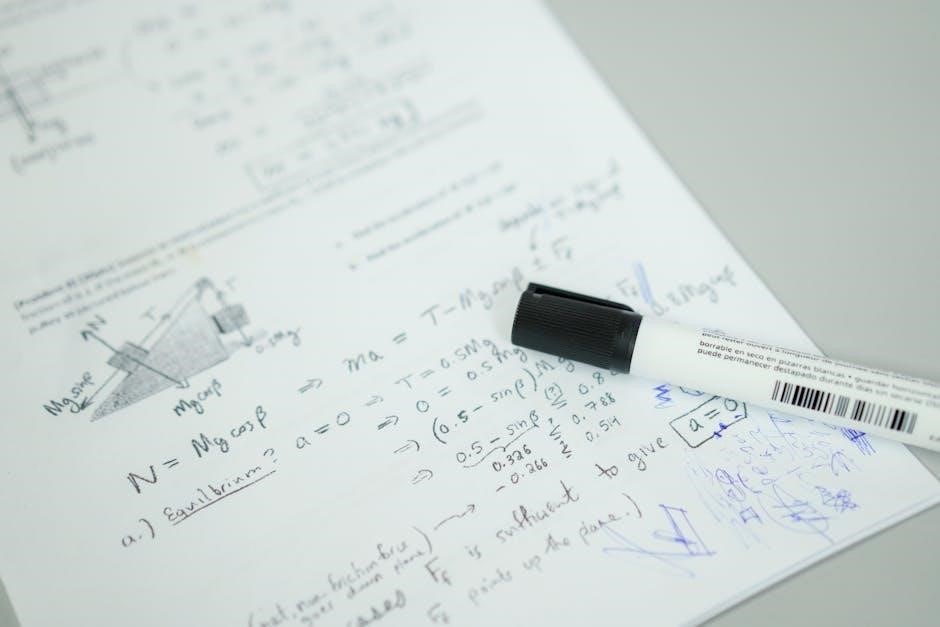Understanding the 6th Grade Math Placement Test PDF
Sixth grade math placement tests, often available as PDF documents, evaluate student skills for appropriate course placement and future academic success.
These assessments, like the Mississippi Academic Assessment Program practice test, help determine quantitative skill levels needed for graduation requirements.
Schools utilize these tests, or similar practice opportunities, to gauge readiness, sometimes even adjusting placement mid-year, as Wellesley Public Schools demonstrates.
What is a 6th Grade Math Placement Test?
Sixth grade math placement tests are diagnostic assessments designed to evaluate a student’s existing mathematical knowledge and skills before entering the 6th-grade curriculum. Often distributed as a PDF, these tests aren’t about grades, but about ensuring students are placed in the math course where they’ll thrive.
They help identify strengths and weaknesses in core areas, like arithmetic, and determine if a student might benefit from accelerated learning or require additional support. Schools use these tests, such as those from the Nebraska State Accountability Mathematics, to tailor instruction and maximize student success.
Ultimately, the goal is optimal placement for a positive learning experience.
Purpose of the Assessment
The primary purpose of a 6th-grade math placement assessment, often found as a PDF, is to accurately gauge a student’s mathematical proficiency. This isn’t about failing or passing; it’s about informed placement. Schools need to determine if students possess the “acceptable level of quantitative skills” required for 6th-grade success, and potentially for future graduation requirements.
These tests help educators identify learning gaps and tailor instruction accordingly. They also assist in deciding if a student is ready for advanced coursework, like jumping to 7th-grade math, as seen in Wellesley Public Schools.
The ultimate aim is student success.
Who Administers These Tests?
Typically, 6th grade math placement tests, often distributed as PDF documents, are administered directly by school districts or individual schools. Local education agencies, like those utilizing the Mississippi Academic Assessment Program, oversee the process.
Sometimes, states, such as New York, provide educator guides and test manuals for grade-level assessments. However, the actual administration usually falls to school personnel – teachers, assessment coordinators, or district staff.
While online platforms offer practice tests, the official placement tests are school-managed.

Content Areas Covered in the Test
Sixth grade math placement tests commonly assess arithmetic operations, fractions, decimals, ratio reasoning, and basic geometry concepts, preparing students for future coursework.
Arithmetic Operations
Arithmetic operations form a foundational component of 6th grade math placement tests, evaluating a student’s proficiency with whole numbers, integers, and basic calculations. These tests frequently include problems requiring addition, subtraction, multiplication, and division skills.
Expect questions testing order of operations (PEMDAS/BODMAS) and the ability to apply these skills to real-world scenarios. The assessment may also include evaluating a student’s understanding of number properties and their application in simplifying expressions.
Mastery of these core arithmetic skills is crucial for success in more advanced mathematical concepts, making this a heavily weighted section on many placement tests.
Fractions and Decimals
Sixth grade math placement tests heavily emphasize understanding of fractions and decimals, assessing skills in simplification, comparison, and conversion between the two. Expect problems involving adding, subtracting, multiplying, and dividing both fractions and decimals.
The assessment will likely test the ability to represent fractions as decimals and vice versa, alongside applying these concepts to solve word problems. Students should be prepared to work with mixed numbers and improper fractions.
A solid grasp of these concepts is vital, as they build the foundation for more complex mathematical operations later on.
Ratio and Proportional Reasoning
Sixth grade math placement tests frequently include ratio and proportional reasoning problems, evaluating a student’s ability to understand relationships between quantities. Expect questions involving finding equivalent ratios, determining unit rates, and solving proportions.
These assessments often present real-world scenarios requiring students to apply proportional thinking, such as scaling recipes or converting measurements. The ability to recognize and utilize proportional relationships is crucial.
Students should be comfortable setting up and solving proportions to find missing values, demonstrating a strong grasp of this fundamental mathematical concept.
Geometry Basics
Sixth grade math placement tests commonly assess foundational geometry basics, including identifying and classifying two-dimensional shapes like triangles, quadrilaterals, and circles. Students should understand concepts like area and perimeter, applying formulas to calculate these measurements.
Expect questions involving angles – recognizing right, acute, and obtuse angles – and understanding their relationships within shapes. The tests may also include simple spatial reasoning problems.
A solid understanding of geometric vocabulary and the ability to apply basic geometric principles are essential for success on these assessments.

Test Format and Structure
Sixth grade math placement tests, often in PDF format, primarily utilize multiple-choice questions, with varying numbers of questions and strict time constraints for completion.
Multiple-Choice Questions
Sixth grade math placement tests overwhelmingly rely on multiple-choice questions to assess a student’s understanding of core mathematical concepts. These questions are designed to efficiently evaluate skills across various topics, from arithmetic operations to geometry basics. The format allows for standardized scoring and comparison between students.
Each question typically presents a problem or scenario, followed by four or five answer options. Students must select the single best answer. Some tests, like skills assessments with 20 questions, assign point values to each question, potentially varying based on difficulty. This format is common in practice tests, such as those for the Nebraska State Accountability Mathematics assessment, preparing students for the actual exam structure.
Number of Questions and Time Limits
The number of questions on a 6th grade math placement test PDF varies depending on the provider and specific assessment goals. Some tests, like a skills test example, contain 20 questions divided into sections – for instance, 15 questions in Section 1 and 30 in Section 2. Others may have a fixed total, requiring students to complete all items within a set timeframe.
Time limits are crucial, often designed to assess not only mathematical ability but also speed and efficiency. While specific durations aren’t universally stated, the emphasis on practice tests suggests time management is a key skill being evaluated. Students should familiarize themselves with pacing during preparation.
Scoring System and Interpretation
Scoring systems for 6th grade math placement test PDFs differ; some utilize point-based systems, awarding 3 points per correct answer, as seen in example skills tests. Passing scores are often defined by thresholds within sections – for example, 10+ correct in Section 1 and 8+ in Section 2.
Interpretation of results guides placement decisions. Scores below established levels may indicate a need for review or placement in a foundational course. Conversely, high scores can allow students to accelerate. The ultimate goal is targeted learning and appropriate course selection.

Accessing 6th Grade Math Placement Test PDFs
PDFs are available from official test providers, school districts, and online platforms offering practice tests aligned with Common Core standards for 6th grade math.
Official Test Providers
Official test providers, while not always directly offering downloadable PDF versions of full placement tests to the public, often provide detailed information about test content and format.
Resources like the New York State Education Department (NYSED) offer grade-level Educator Guides at nysed.gov, containing sample questions and test manuals for grades 3-8 math.
These guides, though not complete tests, provide valuable insight into the types of problems students will encounter, aiding in focused preparation. Furthermore, understanding the assessment structure is crucial, and official sources are the best place to start.
Direct access to full PDF tests may require contacting the school district or specific testing organizations.
School District Resources
School districts are often the primary source for 6th grade math placement test PDFs or information regarding access to these assessments.
Many districts utilize standardized tests, like those from the Nebraska State Accountability system, providing practice tests directly to students and parents.
Contacting your child’s school or district’s assessment coordinator is the most reliable way to obtain specific PDF documents or learn about testing procedures.
Districts may also offer online portals or learning management systems where practice materials and sample questions are available. Check your school’s website for relevant resources.
Online Practice Test Platforms

Numerous online platforms offer 6th grade math practice tests, often mirroring the format and content of actual placement assessments, though direct PDF access varies.
These platforms provide a convenient way for students to familiarize themselves with question types and build confidence before the official test.
Many services tailor tests to the Common Core curriculum, simulating a real exam environment with timed sections and scored results.
While not always providing a downloadable PDF, these platforms offer valuable practice and immediate feedback, aiding in skill development and test preparation.

Preparing for the 6th Grade Math Placement Test
Preparation involves reviewing core math concepts and utilizing practice tests; familiarizing oneself with question formats boosts confidence and improves performance.
Reviewing Core Math Concepts
Effective preparation for the 6th grade math placement test necessitates a focused review of fundamental mathematical principles. Students should revisit arithmetic operations – addition, subtraction, multiplication, and division – ensuring fluency and accuracy.
A strong understanding of fractions and decimals is crucial, including conversions and operations with these numbers. Ratio and proportional reasoning skills are also essential, as are basic geometry concepts like area and perimeter.
Prioritize areas where students feel less confident, utilizing textbooks, online resources, and previous classwork. Consistent review, coupled with practice, builds a solid foundation for success on the assessment.
Practice Tests and Sample Questions
Utilizing practice tests is paramount when preparing for the 6th grade math placement test. Numerous online platforms offer tests aligned with the Common Core curriculum, simulating the real exam environment.
Familiarizing oneself with the test format – primarily multiple-choice questions – reduces anxiety and improves time management. Working through sample questions helps identify knowledge gaps and reinforces learned concepts.
Resources like the Nebraska State Accountability Mathematics Grade 6 Practice Test provide valuable experience. Analyzing answers, even correct ones, clarifies reasoning and strengthens understanding, leading to improved performance.
Strategies for Answering Questions
When tackling the 6th grade math placement test, prioritize careful reading of each question, especially word problems. Underline key information and identify what the question is specifically asking.
Show your work, even for multiple-choice questions, to minimize calculation errors and facilitate review. If stuck, eliminate obviously incorrect answers to increase your chances of selecting the correct one.

Manage your time effectively; don’t spend too long on any single problem. Remember, a score of 10 or more correct on Section 1 indicates strong foundational skills.

Analyzing Test Results
Test results pinpoint student strengths and weaknesses in math, guiding targeted learning and informing placement decisions for optimal academic progression.
Scores help determine if students are ready for advanced coursework or require additional support to master core concepts.
Identifying Strengths and Weaknesses
Analyzing a 6th grade math placement test PDF reveals crucial insights into a student’s mathematical foundation. Examining scores across different content areas – arithmetic, fractions, ratios, and geometry – highlights specific skill proficiencies.
For instance, a strong performance in arithmetic but struggles with fractions indicates a need for focused practice on fractional concepts. Conversely, excelling in geometry while facing challenges with ratio and proportional reasoning suggests targeted support in those areas is necessary.
Identifying these patterns allows educators and parents to create personalized learning plans, addressing individual needs and maximizing academic growth.
Using Results for Targeted Learning
6th grade math placement test PDF results are most valuable when used to inform individualized learning paths. Weaknesses identified – perhaps in fractions or ratio reasoning – should prompt focused review of core concepts.
Utilize online resources, practice tests, and supplemental materials specifically addressing those areas. Conversely, strengths demonstrate areas where students can explore more advanced topics or engage in enrichment activities.
This targeted approach ensures efficient use of learning time, building confidence and fostering a deeper understanding of mathematical principles, ultimately leading to greater academic success.

Placement Decisions and Next Steps
6th grade math placement test PDF outcomes directly influence course placement decisions. Scores falling below established benchmarks – like 10 correct on Section 1 – may indicate a need for foundational review before advancing.
Some schools, like Wellesley Public Schools, are shifting towards a more dynamic approach, using initial 6th grade performance to determine readiness for 7th grade math.
Regardless, results should initiate a conversation between educators, students, and parents to collaboratively chart a course maximizing learning potential and ensuring continued mathematical growth.

Example Problem Types
6th grade math placement tests frequently include word problems, average calculation problems, and questions utilizing point-based systems for scoring, as seen in sample tests.
Word Problems
Word problems are a staple of 6th grade math placement tests, assessing a student’s ability to translate real-world scenarios into mathematical equations. These problems require careful reading and comprehension to identify relevant information and the necessary operations.
Expect scenarios involving distances, quantities, or rates of change. For example, a typical problem might ask about calculating the total cost of items purchased, or determining the speed of an object given distance and time.
Successfully solving these problems demonstrates not just computational skill, but also critical thinking and problem-solving abilities, crucial for future math coursework.
Average Calculation Problems
Average calculation problems frequently appear on 6th grade math placement tests, evaluating a student’s understanding of central tendency. These problems often present a series of scores or values and require calculating the mean, or average, of that set.
A common example, as seen in provided resources, involves calculating a student’s fourth test score given their previous scores and a new overall average;
Students must demonstrate proficiency in adding values, dividing by the total number of values, and interpreting the resulting average within the context of the problem.
Point-Based Question Systems
Some 6th grade math placement tests utilize point-based question systems, where each question carries a different weight depending on its difficulty or complexity. This contrasts with simple right/wrong scoring.
An example illustrates a skills test with 20 questions, awarding 3 points for each correct answer. This system allows for nuanced evaluation beyond simply counting correct responses.
Students must understand not only the mathematical concepts but also how to maximize their score by strategically tackling questions based on their point value and confidence level.
